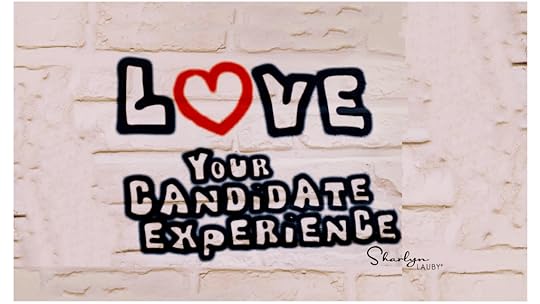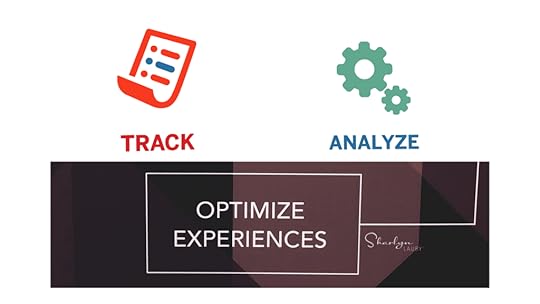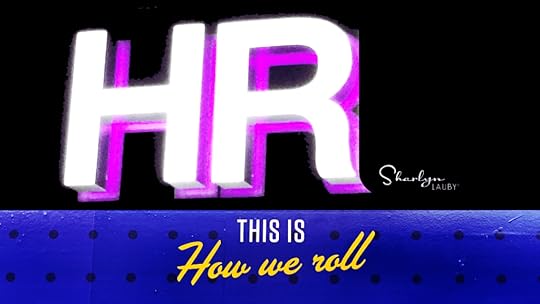Sharlyn J. Lauby's Blog, page 32
October 17, 2023
Knowing What Introvert and Extrovert Mean – hr bartender

Estimated reading time: 3 minutes
Today’s article is about two definitions.
Introvert means a person who prefers calm environments, limits social engagement, or embraces a greater than average preference for solitude . I’ve always thought of an introvert as someone who gets their energy from being quiet or having time to themselves.
Extrovert means having a disposition that is energized through social engagement and languishes in solitude . So in contrast to introverts, extroverts get their energy from being with people in teams or on group activities.
The reason I’m bringing up extroverts and introverts is because I recently participated in a meeting where someone got these definitions wrong. And on top of that, they implied that being an extrovert is better than being an introvert because you have to be outgoing and gregarious in order to be successful.
I believe we need to be careful when attaching labels to people, even labels like extrovert and introvert. Because the truth is we’re a little bit of both. We might find that we gravitate toward one or the other at home versus at work. Or we tend to feel one way around certain groups and differently in others.
In fact, it’s possible if we would self-identify as an extrovert that maybe we’re working through a challenge and deliberately focused on introverted qualities like a calm environment and spending time alone. The reverse could also be true. An individual who self-identifies as an introvert might be in a new role and trying to build new work friendships by spending more time with others.
Organizations need employees to have both introvert and extrovert qualities. Teams need both as well. As individuals, we know our preferences. That being said, as individuals we should be willing to share our preferences and occasionally flex to meet the needs of the situation. And if we’re on the receiving end – meaning that someone is asking us to give them space or asking to be included with the group – we need to figure out how to respect them.
The meeting I was in recently reminded me of a few things.
Know the meaning of the words you use. No one is 100% introvert or extrovert. We have a bit of both. While we know our preferences, there might be times when we need to flex. We need to respect the preferences of others.As organizations spend more time talking about returning to the office and the benefits of collaboration, knowing what extrovert and introvert mean will become incredibly important.
Image captured by Sharlyn Lauby while exploring the streets of Havana, Cuba
The post Knowing What Introvert and Extrovert Mean – hr bartender appeared first on hr bartender.
October 15, 2023
The 4 Key Elements of An Effective Recruiting Strategy

Estimated reading time: 3 minutes
When we’re creating our recruiting strategy, we have to decide how we will bring people into the organization. I’m not talking about sourcing. I’m talking about when there’s an open job, we have to decide if we will fill it from within, hire someone from the outside, or maybe even outsource the work to a consultant. We often refer to this decision as buy, build, or borrow. As a quick refresher, here’s a brief explanation of each.
BUY is where the company hires workers from the outside. The advantage to this recruiting approach is that the organization gets fresh perspectives and new ideas. The disadvantage is that it can be expensive to attract high performing workers from the outside. And the organization needs to make sure the new hire acclimates to the company culture.
BUILD is when the company develops their existing workforce. The upside is that this strategy is great for employee morale. And the employee already knows the culture and has built working relationships. The downside is that developing a future workforce takes time. It also means having the learning and development resources available.
BORROW is using freelancers, contractors, or consultants when the need arises. Not every job is a full-time job, so the positive side to this approach is getting the necessary skills at the moment it’s needed. The challenging side is keeping freelancers engaged so that, when you need them, they’re available and ready to work for you.
In today’s technology age, I think we need to add one more recruiting strategy component to the list – bots. The groups I described above all rely on human beings. Advances in technology, like artificial intelligence (AI) and bots, are allowing organizations to do things never before possible.
Please note, I’m not suggesting that we eliminate the human workforce. It’s important to realize that while AI and bots are an important technological advancement, they haven’t been developed to the point where they can replace all human workers. But I’m thinking if we added bots to the buy, build, and borrow elements, this is what it could look like.
BOTS would be used when the organization has a defined, predictable, repetitive task. The plus would be that the organization would gain consistency and scalability in managing these kinds of tasks. Employees could focus on work that only humans can do. The minus would be initial investment costs as well as the perceived loss of human interaction.
I know bots are getting mixed reviews right now, but I can see this fourth element in recruiting strategy being important in future staffing discussions. Organizations need to ask: Is this a full-time, part-time, freelance, or bot job? That will determine how an organization goes about finding the worker (i.e., sourcing). Do they buy it, build it in-house, have someone occasionally work on it, or automate it?
The workforce is changing. Even if your organization isn’t looking at AI and bots right now, it’s possible they will be in the future. HR and talent acquisition professionals need to be prepared for a strategic response.
Image captured by Sharlyn Lauby while exploring the streets of Miami, FL
The post The 4 Key Elements of An Effective Recruiting Strategy appeared first on hr bartender.
October 12, 2023
Make Interview Questions Relevant to the Job – hr bartender

Estimated reading time: 3 minutes
I’ve heard a few employees recently discuss how their manager is forcing them to talk about their personal life. Some employees are taking it in stride, but others are developing lies, half-truths, and stories (whatever you want to call it) just to get their manager to stop. You know what I mean, the employee develops a reply so different from what was expected that there’s no further questions.
This isn’t good. Employees shouldn’t be forced to discuss their personal lives. And they shouldn’t feel like they have to concoct stories to get managers to stop. It does make me wonder about the level of trust in the workplace.
It also made me think about questions often asked during interviews or in training like “If you were a tree, what kind of tree would you be?” or “What superhero do you identify with?” or “What dog describes your leadership style?”. These types of questions don’t really have anything to do with the job.
Yep, I get it … they can be considered what some people call “fun icebreakers”. When we’re trying to build relationships, finding things in common can be helpful. But for candidates and employees who are trying to be taken seriously, these types of questions might not help. They have the potential to label people and create bias. For example, what happens when someone in a group says, “Oh, there’s pit bull from our leadership skills training.” Or “Can you believe they like Rocket Raccoon?!” after an interview.
From an interview perspective, there’s no reason to ask non-work-related questions. The purpose of an interview is to figure out if the candidate has the knowledge, skills, and abilities to do the job. What’s your superpower doesn’t tell you what kind of employee someone is or will be. If the reason you’re asking that question is because you want to know what a candidate considers their greatest strength … then ask that question. It’s work related.
I will admit training icebreakers are tougher. They are filled with questions like “What’s the best concert you’ve ever been to?” or “What TV show do you think is overrated?”. While I’ve never received any pushback from these types of icebreaker questions, I am finding that work related icebreakers are generating some nice conversation. Examples include “Have you ever had a mentor?” or interviewing a co-worker about their job.
The purpose of today’s article isn’t to say don’t get to know the people you work with. Because work is better when we have positive working relationships with the people around us. But maybe we need to become more cognizant of how we go about building those work relationships. They might take more time and effort. Since we start by asking candidates work-related interview questions, we might need to give people space and let them share their personal lives on their terms.
That also means being respectful when people do share the personal lives. We all know that there’s divisiveness in today’s society. Some coworkers might feel that the way to stay out of the divisiveness and avoid personal conflict at work is to only talk about the work and limit the amount of personal information they share. I’m not saying that’s right or wrong, but you can see how people might feel that way.
Ultimately, we have to build good working relationships. And if that means giving others their space when it comes to talking about their personal lives, then so be it. Because if you genuinely respect others, it will help you build better working relationships.
Image captured by Sharlyn Lauby at the HR Technology Conference in Las Vegas, NV
The post Make Interview Questions Relevant to the Job – hr bartender appeared first on hr bartender.
October 10, 2023
Employee Feedback Can Help Employers Save Money – hr bartender

Estimated reading time: 3 minutes
I recently saw the question “How can organizations save money?” in one of my Facebook groups. The group had some very good suggestions like conducting a benefits audit and reviewing all vendor contracts. But there are a couple of things that organizations need to think about before just cutting expenses, especially employee related expenses.
Call me a realist, but I’ve always believed that organizations are in business to make money. This doesn’t mean that organizations don’t practice corporate social responsibility and don’t give back to their communities. But at their core, companies want to make money. Even non-profit organizations want to make money so they can fulfill their mission. So, organizations need to think about finding ways to increase revenue. Companies don’t grow just by cutting expenses. They grow by increasing profits.
Of course, one of the ways to improve the revenue line is by keeping expenses under control. Organizations should look at regularly occurring expenses to make sure they’re being used. No different than we do in our personal lives. For example, the fees for those very convenient subscriptions programs can add up. And if we’re using them – great! But if we’re not, then we need to ask why and possibly make adjustments or cancel them all together.
But there’s another way that organizations can increase revenue. It’s by getting employee feedback. Front line employees have great suggestions for how to increase revenue and decrease expenses.
True story. Years ago, I worked for a company that was forecasting a shortfall of one million dollars. This was a lot of money to the company, and they were trying to figure out how to deal with the situation. Finally, the company decided to go to employees with the problem and a potential solution.
They told the workforce about the million dollar shortfall and said if any employee (or group of employees) could come up with an idea that would either 1) decrease expenses or 2) increase revenue, the company would consider it. The idea would be vetted in the organization, meaning that not every idea would automatically be implemented. And if the idea decreased expenses by $XX or increased revenue by $XX, then the employee / group would get XX%.
Forgive me because I don’t remember the exact amounts and percentages from back then, but you get the point. There was a minimum dollar amount that needed to be saved or generated. It wasn’t hundreds of thousands of dollars, but it was in the tens of thousands. If it worked, then the employee or group would get a thank you bonus equal to a percentage of the savings or monies generated.
The program was a huge success. It not only generated the one million dollars that the company was looking for … it generated five million more.
The point of my story is this. Before the company just starts cutting headcount or benefits (and potentially angering employees), organizations facing a challenge should share that challenge with employees. Because employee feedback might have a great idea that would help fix the problem. And if employees help fix the problem, thank them. And thank them well. You’ve probably seen the same photo I have from the company that made $90 million dollars last year and decided to thank employees with cupcakes. Granted, I like cupcakes too, but I hardly think the thank you aligns with the effort.
Organizations are always going to have some sort of challenge that they’re dealing with. Start putting a process in place to ask and get employee feedback. Employees have great ideas. Use them.
Image captured by Sharlyn Lauby after speaking at the SHRM Annual Conference in Las Vegas, NV
The post Employee Feedback Can Help Employers Save Money – hr bartender appeared first on hr bartender.
October 8, 2023
What You Know is Not as Important as How You Think – hr bartender

Estimated reading time: 4 minutes
The title of today’s article comes from Neil deGrasse Tyson’s MasterClass on Scientific Thinking and Communication. A while ago I shared with you that I received a free trial membership to MasterClass and wrote an article on my takeaways from listening to “Good Omens” author Neil Gaiman talk about storytelling.
Today I want to share with you my takeaways from Neil deGrasse Tyson’s MasterClass. Tyson is an astrophysicist and science communicator. I first heard of him when he was part of the effort to reclassify Pluto as a dwarf planet. Regardless of your views about Pluto’s planetary status, Tyson has raised public interest in science. And because critical thinking and communication are a part of the HR competency model, I wanted to hear what he had to say.
Tyson started his MasterClass talking about the importance of thinking. It reminded me of the Shultz Hour – when former Secretary of State George Shultz would schedule an hour on his calendar just to think in solitude. As businesspeople, we need to dedicate time just to think. Tyson’s comments about critical thinking not only apply to science but to business as well.
Be aware of when we’re being “intellectually lazy”. Tyson describes intellectually laziness as when we agree with something immediately (without question) and/or when we dismiss something immediately (without research). When we’re presented with information, we should have a healthy skepticism (not rejection). A proper skeptic questions what they are unsure of and recognizes when something has been proven. Practice processing information from people we don’t like. One of the things I really liked about this MasterClass was the focus on misinformation and disinformation. We’ve talked before about the importance of social media literacy. We need to recognize that someone we like might tell us a lie and that doesn’t make it the truth. And we also need to realize that someone we don’t care for might actually tell us the truth. Know when to stop and start measuring. Metrics, measurement, and analysis are a big part of our roles in business. That’s great. But organizations need to identify what they should measure. Not everything needs measuring. Then, organizations should figure out how much data is necessary. Think about the concept of analysis paralysis. We can get so caught up in looking at data that we don’t ever make a decision. Know the extent you need to measure something. This is related to #3 above. Everything does not need to be measured to the same extent. It reminded me of Pi, which is the ratio of a circle’s circumference to its diameter. Some organizations might have measurements that require eleven digits to the right of the decimal point (3.14159265359). But there could be others that 3.14 will do. The management team should reach consensus on how to measure things.Empathy is important. So far, I’ve been talking about data gathering and processing information. But the second part of all this critical thinking is being able to communicate your findings. That’s where empathy comes in. Tyson reminded me that empathy is knowing history (and what people have gone through). Also, empathy is knowing pop culture (and what people respond to). We must remember that a big part of communication is understanding our audience and communicating on their level.My last takeaway from his session was “Being right isn’t enough. We have to be effective.” It’s sometimes very easy to sit on the sidelines and say, “I told you so.” when it comes to organizational decisions. We can tell ourselves that we did our job, crunched the numbers, and drafted the recommendations. If the organization doesn’t take our suggestion, well that’s on them. But maybe we need to ask ourselves, “Why didn’t the company listen?”
I remember in my first manager role going to a weekly meeting where we would go around the table and talk about what we were working on. The other department managers would mention that they needed additional resources like budget dollars or headcount. And they got them. When it came to me, sometimes I got what I wanted and other times not. Frankly, it made me mad. I couldn’t figure out why I wasn’t being effective.
Then I realized that when my colleagues talked about their projects, they mentioned business metrics and measurements. When I talked about my projects, I talked about what made the employees feel good. That’s not to say what makes employees happy isn’t important. But when I could take employee satisfaction and turn it into a number … well, I got what I wanted too.
That’s why analytics and critical thinking are so important. It’s also why being able to communicate analytics is critical. Organizations aren’t going to stop using data to make decisions. As human resources professionals, we need to allocate more time to keeping our skills sharp in this area. But you don’t have to read a math textbook to learn analytical skills. You can find examples everywhere in popular news and culture.
Image captured by Sharlyn Lauby while exploring the streets of Salt Lake City, UT
The post What You Know is Not as Important as How You Think – hr bartender appeared first on hr bartender.
October 5, 2023
Organizations: Be Sure to Have a 2023 COVID Plan

Estimated reading time: 3 minutes
I realize that no one wants to talk about COVID. But let’s talk about it anyway. Because people are still getting COVID and COVID is still extremely contagious. Today’s article isn’t about masks, even though I’m starting to see more people wearing them. It’s also not about vaccines, even though they were recently approved for distribution.
Organizations want employees to return to the office. I understand that. I’m not here today to talk about whether organizations should demand that employees return to the office.
I wanted to have a chat about COVID today because we’re seeing an increasing number of articles on the subject. So, let’s talk about the likely scenario that an employee or group of employees might call in one day and say they can’t come to work because they have COVID. Hopefully, it never happens. But I do believe organizations should have a COVID plan ready.
Back when the pandemic first happened, we spent a lot of time saying, “I don’t know.” And “We’ve never dealt this this before.” It was true. This was totally unlike anything we’ve ever experienced. But now, over three years later, I’m not sure we can still say that. Organizations should have a plan and be prepared to use it. If an organization doesn’t have a plan, I could see an employee saying to themselves, “Really?! After everything we’ve been through?! You didn’t think this could happen?!”.
Again, this is one of those situations where it makes sense to have a plan and if you never use it … all the better. Here are a few things to think about:
Is your workplace doing things to mitigate and prevent the spread of COVID? There’s information on the Occupational Safety and Health Administration website. It might make some sense to refamiliarize everyone with this information.
How will the company handle a call from an employee or group of employees who say they contracted COVID? Not just the sick pay, but how will the operation function? For example, if you have a handful of salespeople attend a conference and they all come back with COVID, what will you do?
If an employee calls in and says a family member has tested positive, what does that mean in terms of the employee coming into the office? On one hand, the employee doesn’t have COVID. On the other, COVID is still very contagious.
These are just a few questions that the organization needs to ask. I’m confident there will be more. And I’m not an attorney so it might make good business sense to call your legal counsel and find out their thoughts. It’s better to have this conversation proactively than reactively. Also, so much has happened over the past few years, I don’t know if the actions we took back when the pandemic started are the same actions we would take today. That’s why seeking the knowledge of others is critical.
Organizations want to know that they will be able to operate their business safely. Employees want to know that they work in a safe environment. Right now, there are no predictions that we’re going to see caseloads at peak pandemic levels. But that doesn’t mean with everyone coming back to the office that there won’t be times when more than the usual number of employees might be out with COVID. So, make a plan. Have it ready.
Image captured by Sharlyn Lauby while exploring the streets of Austin, TX
The post Organizations: Be Sure to Have a 2023 COVID Plan appeared first on hr bartender.
October 3, 2023
HR: Know Immediately When Employment Laws Change

Estimated reading time: 4 minutes
(Editor’s Note: Today’s article is brought to you by our friends at HRdirect , a trusted source for employee-related compliance, administration, and motivation tools. They serve as a one-stop shop to make employee management easier. Enjoy the read!)
I recently posted a list of federal law changes that require new poster updates. Those federal laws are the Providing Urgent Maternal Protections for Nursing Mothers (PUMP) Act, and the Pregnant Workers Fairness Act (PWFA). Of course, in mentioning these federal laws, this doesn’t include any state or local labor law changes.
But it got me thinking. I’m sure there are some organizations that might be saying, “Wouldn’t it be great if we had a way to know about labor law changes sooner?”. The faster organizations become aware of changes in legislation, the faster they can put a compliance plan in place. While I mentioned labor law posting changes, some law changes might require additional updates to policies, job applications, and handbooks. Or maybe require employee handouts.
Being able to take a more proactive approach to compliance can also reduce any liability (i.e., fines and penalties) for non-compliance. And it shows everyone that the organization places an emphasis on following the law.
Well, our friends at HRdirect have introduced a new Employment Law Alert Service. This is an annual subscription service that will keep your organization informed of recent employment law changes on a federal, state, county, and city level. Here’s how it works:
HRdirect’s expert legal team will monitor employment-related legislative activity around the U.S. including over 20,000 agencies. The types of employment-related legislation that will be monitored include:
Minimum wage, equal pay, and salary history;Discrimination and harassment;FMLA, sick pay, bereavement, meal breaks, and rest periods;OSHA, safety, and smoking in the workplace;And many others.When there’s a change, you’ll receive an attorney reviewed and approved email alert. The email will summarize the law – in plain language – and provide a link to the full text of the legislation for reference. It will also offer some guidance on how to comply with the new or updated law.
This alert service positions the organization to quickly understand the change and immediately make compliance decisions. In addition to the email alerts, subscribers will have access to a database of recent alerts with suggested next steps.

The good news is that right now, HRdirect is offering a two-month FREE trial. And the even better news is that you don’t have to put a credit card on file to sign up. After the free trial, you will receive a $30 discount on an annual subscription. Honestly, that’s a great deal. And since you don’t have to put a credit card on file … you have nothing to lose by testing it out. There are three things I really like about this service.
As an HR professional, I can feel comfortable that legal professionals are watching out for legislation that impacts my organization. That’s time I can spend doing other things like recruiting and training. At the point there’s a new law or a change, I have a summary and some talking points that I can share with my team and senior management team. We can strategize on the right next step for our organization and workforce. Lastly, I can use the database to conduct a mini-audit and make sure my company remains in compliance. Great project for wrapping up the fiscal year. We can start the new year knowing we’re doing all the right things.Compliance is an important part of our role as human resources professionals, but it doesn’t have to be the only thing we do. Finding partners who can help us maintain compliance just makes good business sense.
I hope you’ll check out the new Employment Law Alert Service that HRdirect is offering and take advantage of the free trial. It’s a great opportunity to stay compliant, make your work easier, and provide greater value to the organization.
The post HR: Know Immediately When Employment Laws Change appeared first on hr bartender.
October 1, 2023
Make Creating Change a Part of Your Professional Life

Estimated reading time: 4 minutes
Over the past couple of months, I’ve been watching / listening to MasterClass sessions. I received a free subscription from my cellular provider. It’s been a great experience so far and today’s article on the MasterClass from Malala Yousafzai is no exception. She is a Pakistani female education activist and the world’s youngest recipient of the Nobel Peace Prize.
We’ve published articles on HR Bartender about being a better ally and how an organization’s social and political views can impact their brand. We also have an entire season of The HR Bartender podcast focused on change management. In listening to Malala’s MasterClass, I thought she did a fantastic job of helping people understand that anyone can influence change – whether that’s in our personal or professional lives. Here are a few of my takeaways from the class that we can apply to our business lives.
Define your values. This MasterClass was focused on personal activism, but I could see how defining your values would be a healthy exercise when it comes to our careers. Here’s are the steps Malala shared:
Write down all the things that are a “hard no” for you. The things you would never do.Then write your “yes” list, which might not necessarily be the “hard no” list in reverse. Recognize there could be some things that sit in the middle or a gray area. Finally, use these lists to start defining your values. Keep in mind that some values might be related to your religious, cultural, or societal beliefs.Learn how to listen. If we want to influence others and create change, we need to learn how to listen. We have to gain perspective. We can’t be so focused on our point of view that we aren’t willing to listen to opposing views. Please note: I didn’t say we have to agree with everything we hear. But we need to be able to listen … really listen.
Research. You can’t address a problem if you don’t know what it is. You can start with desktop research (i.e., the internet) and then start talking with people to gain their perspective (see above comments on listening). Keep in mind that we need to be able to identify misinformation and disinformation. We need to have methods in place to assess the accuracy of the information we’re exposed to.
Practice your message. If you have a change you want to see happen, be able to talk about your change at any time. Be able to repeat your message in multiple ways. Adjust your words to reflect your audience. An effective argument might be different from the ones you’re comfortable with so practice conveying your message in different ways.
Build a network. One of the things that was unique about Malala’s MasterClass was that she interviewed other activists about their efforts. There was an acknowledgement by all of them that they needed the support of others to create change and have an impact. This happens in organizations all the time. We can create change by building a coalition of support.
Proactively manage obstacles and setbacks. Another thing I liked about Malala’s message was that she openly addressed there were setback and obstacles along the way. It wasn’t a question of “if” these things happen, it was “when”. By addressing obstacles upfront, it can keep the change effort on track. Think of it as “We knew this could happen, it did happen, and we have a plan.”
Stories like Malala’s are inspirational. But don’t let the magnitude of the story discourage you. I remember years ago, someone telling me that if they couldn’t make the big change that they wanted to make then they didn’t want to do anything at all. It was so disappointing because their ideas were good ones. But they weren’t prepared to give value to small steps. Very often small incremental changes can lead to bigger ones.
This leads to my final takeaway from Malala Yousafzai’s MasterClass. We don’t have to lead a change effort to make an impact. Sometimes I hear people say, “I don’t want to lead the change, so I don’t want to be a part of it.” Or “I’m too old to do this. I’ll let someone else lead the cause.”
Anyone can be a change maker. Influencing change isn’t an “old person” thing or a “young person” thing. Give what you can when you can. That’s how change happens. That’s how we can make an impact in both our personal and professional lives.
Image captured by Sharlyn Lauby while exploring the streets of Las Vegas, NV
The post Make Creating Change a Part of Your Professional Life appeared first on hr bartender.
September 28, 2023
Workplace Attire: Weather Should be a Consideration

Estimated reading time: 3 minutes
I recently saw two articles talking about workplace attire. One of them was mentioned on The Hustle newsletter and it outlined what was considered “business professional attire”. It said that business professional attire for women includes hosiery, light makeup, and simple jewelry. For men, it includes a tie, dress socks that are darker than your pants, and possibly a pocket square.
I think I understand why these articles were published. Let’s face it, during the pandemic, office attire went casual. If you were working from home, there were probably days when you wore a nice shirt and yoga pants or joggers. Now that returning to the office conversations continue to happen, companies want employees to also return to regular business attire. Honestly, I’ve even seen articles about companies conducting etiquette classes for people returning to the office.
But here’s the thing. A lot has changed over the past few years, including what people want to wear. So maybe instead of dusting off a five-year-old workplace attire policy and mandating employees follow it, use this as an opportunity to reevaluate what makes sense. Here are a few things to consider:
SAFETY: First things first. If employees need to wear something because it protects them, then identify those items and clearly explain to employees why they need to wear it. Or possibly not wear something. For example, I’ve worked places where I could not wear hoop earrings because they might get caught on something and injure me. Safety needs to come first.
INDUSTRY: Some industries have long traditions of dressing a certain way. But let me say that some of those traditions are being discarded. The U.S. Senate recently “ditched their dress code” because of a growing number of elected officials want to wear casual attire. It is possible to change traditions. Don’t forget that old quote, “The six most expensive words in business are ‘we’ve always done it that way’.”
COST: Sometimes workplace attire can be expensive to buy and expensive to maintain. Want to give your employees a free pay increase? Don’t make them buy expensive suits that need to be dry cleaned. That doesn’t mean your dress code would become wearing pajamas to work. But there might be something in between that allows employees to look professional without a huge expense.
WEATHER: This brings us to the point I wanted to make about workplace attire and the weather. As you know, I live someplace that’s hot and humid in the summer. This summer was even more hot and humid than usual. We had two solid weeks of extreme heat warnings. Asking employees to wear suits, hosiery, ties, etc. in this kind of weather is unrealistic. Employees are going to be miserable. And when people feel miserable, they don’t do their best work.
I realize we’re going into the cooler weather months but something to consider for the future. Maybe have a summer dress code. We’ve done this before, and it could be a nice compromise. Even the executives loved getting a break from wearing suits for a few months. And the catch was this – if people abused the policy, it went away. Trust me – everyone followed the policy.
Business suits do not turn people into leaders nor make people more professional. We all know unprofessional jerks who wear suits. Our attire helps us to feel confident and comfortable to do the work. And that’s what everyone wants. Employees who feel confident and comfortable doing their jobs.
Image capture by Sharlyn Lauby while exploring the streets of Reykjavík, Iceland
The post Workplace Attire: Weather Should be a Consideration appeared first on hr bartender.
September 26, 2023
Artificial Intelligence and the Candidate Experience – hr bartender

Estimated reading time: 3 minutes
I’ve talked to a few recruiters recently who are very concerned about artificial intelligence (AI) replacing them. It reminded me that several years ago, I asked a few people in the technology and talent acquisition space this very question about technology replacing recruiters. I believe their comments are still spot on today. I hope you’ll check it out when you have a moment.
While I do believe that we have a steep adoption curve where artificial intelligence replacing people is concerned, that doesn’t mean we should ignore AI. We need to be knowledgeable about AI’s capabilities. And we need to be equally aware of what we need to do to stay relevant and provide value in today’s work environment.
This doesn’t mean that in the interim, we’re not going to see technology providers add AI components to their software. And it doesn’t mean that we’re not going to see organizations try to bring AI into the talent acquisition process. It does mean that we need to keep the candidate experience in mind as we’re introducing AI to our processes. For example:
I came across an article recently titled, “AI is Racist, Experts Say. Here’s Why”. If candidates believe that AI is racist, then what are the chances that they’re going to apply with an organization that’s using AI in their hiring process? Not very likely.
Now, some of you might say, “I get your point, but the number of people who think AI is racist isn’t significant.” Well, in an article from the American Staffing Association (ASA), they cited a survey that said 49% of job seekers believe that AI tools are more biased than humans. That’s a pretty substantial number.
My point in sharing these articles isn’t to say don’t use AI. It’s to say use AI smartly. Artificial intelligence has tremendous potential for many things including the candidate experience, but it needs to work through some of its challenges. I was pleased to see a recent report from the Society for Human Resource Management (SHRM) that said half of U.S. workers believe the automation of certain duties or tasks would give them more time to focus on other areas of work. Adding everything up, I interpreted this string of articles as:
Yes, employees would like automation.Because it would free them up to do other things of value.But we need to make sure the technology works well.And right now, there’s a big question mark about that.So, getting back to the beginning of this article. As HR professionals, we need to stay current with what’s happening in artificial intelligence. If you’re not aware, the Equal Employment Opportunity Commission (EEOC) has launched an initiative to examine how technologies impact employment decisions. The goal is to help employers, employees, job seekers, and vendors so technology is used in a fair and consistent manner that is in compliance with federal labor laws. In addition, technology companies are meeting with government leaders to discuss AI regulations. This is a complex matter which is why we need to pay attention to what is happening – both from the standpoint of our professional and personal lives. And, of course, the candidate experience.
It will be interesting to see how AI evolves and its connection to the workplace. Ultimately, organizations have to think about the candidate experience and how people perceive these technologies. If applicants are suspect of the organization’s talent acquisition process, they could will be reluctant to apply. And that has a negative impact on the company’s goal to hire the best employees.
We all know what happens when companies are unable to find the best talent. It has a direct impact on the bottom-line. And we don’t need AI to tell us no one wants that.
Image captured by Sharlyn Lauby while exploring the streets of Orlando, FL
The post Artificial Intelligence and the Candidate Experience – hr bartender appeared first on hr bartender.
Sharlyn J. Lauby's Blog
- Sharlyn J. Lauby's profile
- 10 followers



